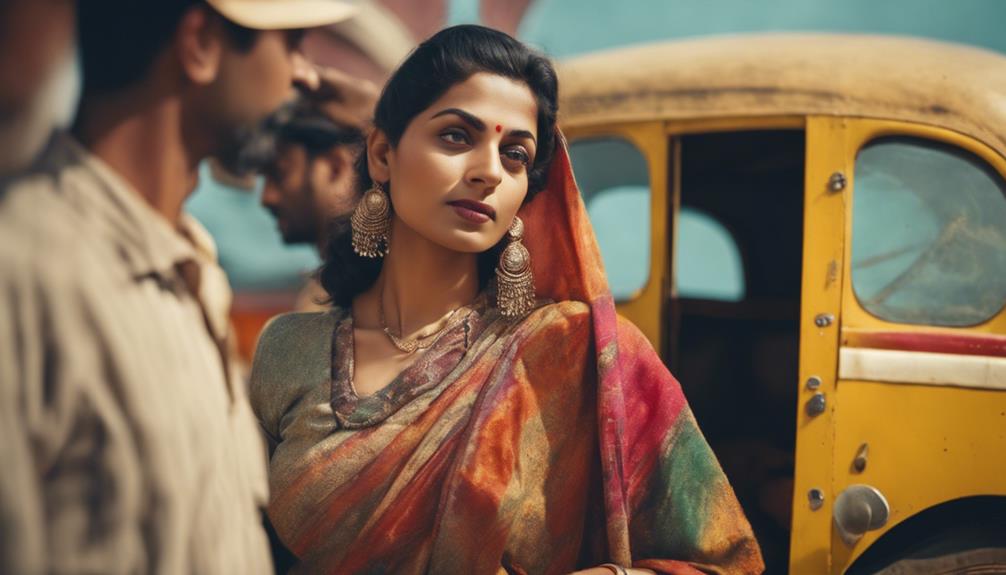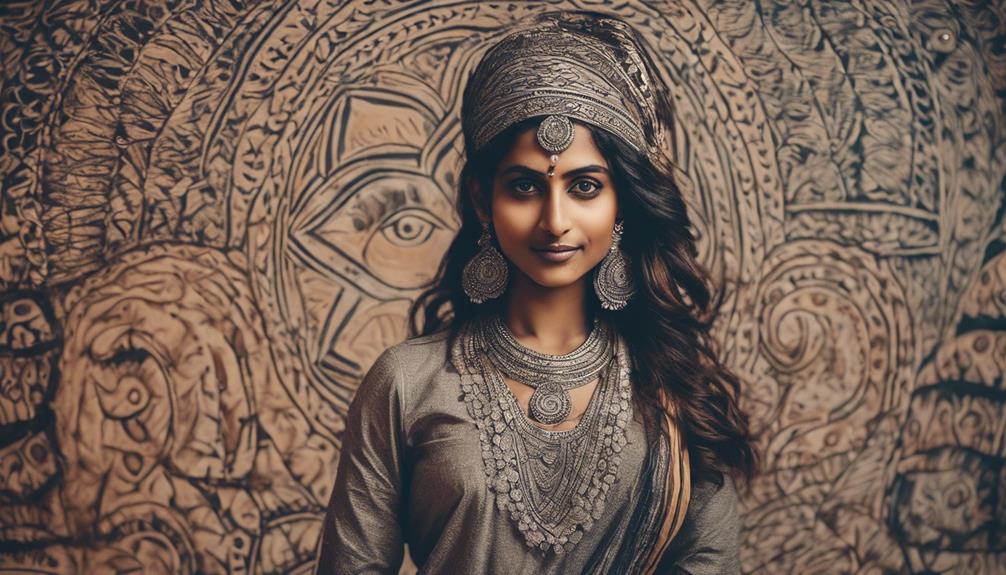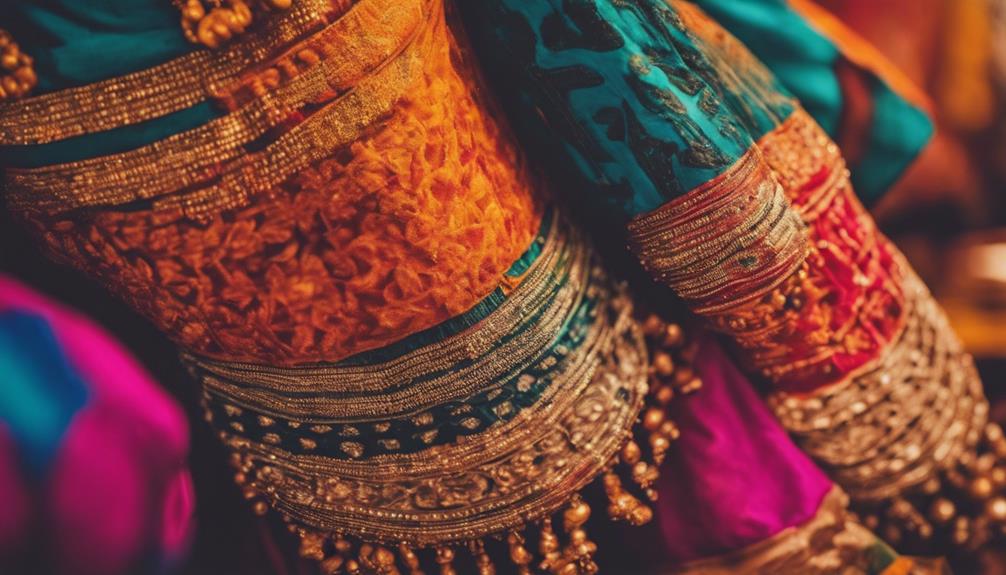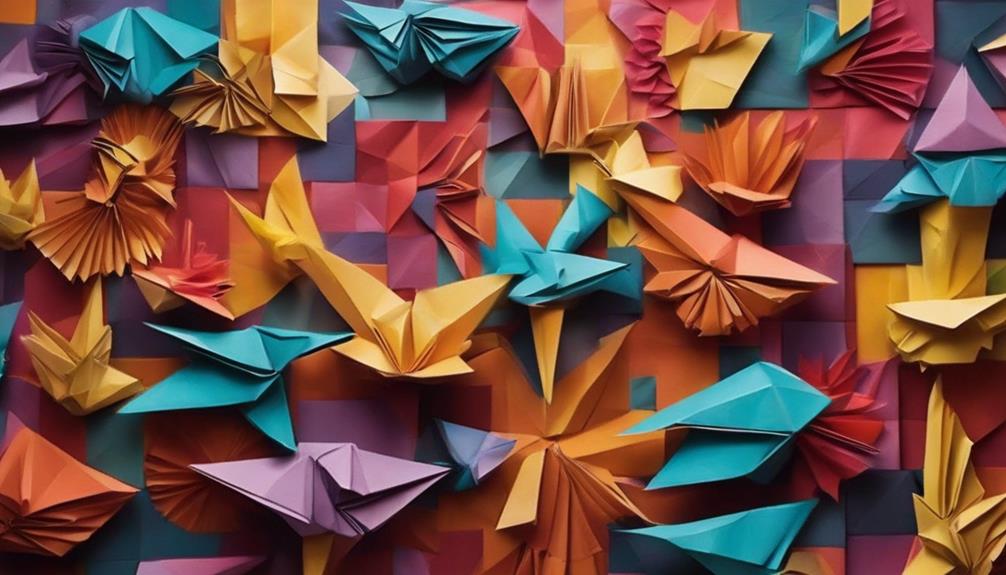The forgotten movement that sparked Indian Modernism was the Bengal School of Art, spearheaded by Abanindranath Tagore in the early 20th century. Its mission was to revive traditional Indian art forms and move away from Western academic styles. This shift had a profound impact on contemporary Indian art, blending Indian and Western techniques to celebrate India's cultural heritage. Through this movement, a new artistic language was established, bridging tradition with modernity and reshaping the course of art history in India. This movement's influence on modern Indian artists and the preservation of cultural heritage remain profound influences in the evolving landscape of Indian art.
Key Takeaways
- Bengal School Movement led by Abanindranath Tagore initiated Indian Modernism.
- Fusion of Indian and Western styles reshaped modern art history.
- Celebration of Indian cultural heritage bridged tradition with modernity.
- Inspired contemporary artists like Anjolie Ela Menon.
- Legacy of Bengal School movement influences modern Indian art scene.
Origins of Bengal School Art
The Bengal School of Art originated in the early 20th century with the vision to revive traditional Indian art forms. Influenced by the Swadeshi movement and a desire to break away from Western academic art styles, the Bengal School sought to revive Indian cultural heritage through art.
This movement played a significant role in shaping the foundation of Indian Modernism by blending traditional Indian art with modern concepts and techniques. The Bengal School emphasized the use of indigenous techniques and themes, aiming to create a unique artistic identity for India amidst the wave of European Modernism.
Prominent artists associated with the Bengal School, such as Nandalal Bose, Asit Kumar Haldar, and Kshitindranath Majumdar, contributed to this fusion of traditional Indian art with elements of modern art in India. By embracing indigenous roots while incorporating new artistic ideas, the Bengal School laid the groundwork for the evolution of modern art in India.
Abanindranath Tagore: Leader and Innovator

Abanindranath Tagore, a trailblazing figure in the domain of Indian art, not only led the Bengal School of Art but also revolutionized the artistic landscape by blending traditional Indian styles with Western techniques.
His innovative approach left an indelible mark on Indian art, inspiring a new generation of artists to fuse traditional and modern elements in their creations.
Tagore's emphasis on Indian cultural heritage continues to resonate in contemporary Indian art, shaping the evolution of artistic expression in the country.
Tagore's Artistic Vision
An influential figure in the initiation of Indian Modernism, Tagore's artistic vision drew inspiration from traditional Indian art forms. He skillfully blended elements from Indian art, such as Mughal miniatures and Bengal folk art, with a modern twist to create a distinctive style that celebrated the rich cultural heritage of India.
Tagore's artistic approach evoked a range of emotions in his audience:
- Pride: By infusing traditional Indian art forms with modern techniques, Tagore instilled a sense of pride in Indian cultural heritage among viewers.
- Wonder: The intricate details and vibrant colors in Tagore's works often left viewers in awe, marveling at the beauty and complexity of his creations.
- Inspiration: Tagore's ability to seamlessly merge tradition with innovation inspired a generation of Indian artists to explore their roots and develop their unique artistic identities.
Through his visionary approach, Tagore paved the way for a renaissance in Indian art, encouraging artists to embrace their cultural legacy while embracing modern influences.
Impact on Indian Art
With his innovative blending of traditional Indian styles and modern design concepts, Abanindranath Tagore emerged as a prominent leader and innovator in the forgotten movement that sparked Indian Modernism. Tagore's impact on Indian art in the twentieth century was profound, reshaping the history of modern art in India. By incorporating elements of Mughal and Rajput architecture, as well as temple art, into his work, Tagore created a unique artistic vision that bridged the gap between tradition and modernity.
| Traditional Indian Styles | Modern Design Concepts | Impact on Indian Art |
|---|---|---|
| Mughal and Rajput architecture | Fusion of vibrant colors | Reshaped modern art history |
| Temple art influences | Embracing traditional styles | Bridged tradition and modernity |
| Rich cultural heritage reflections | Innovative design vocabulary | Inspired contemporary artists |
| Vibrant color palette | Legacy of impactful art movement | Significance in art evolution |
| Fusion of tradition and modernity | Unique design forms | Continued inspiration for designers |
Tagore's legacy continues to influence contemporary artists and designers, highlighting his significant contributions to the evolution of Indian art and design.
Fusion of Indian and Western Styles

The fusion of Indian and Western styles in the Indian Modernism movement was a deliberate effort to blend cultural influences in art. By harmonizing diverse design elements from both traditions, artists sought to create a unique synthesis of traditions.
This blending of styles aimed to establish a new design vocabulary that honored Indian heritage while embracing modern influences.
Cultural Blend in Art
In the domain of art, a harmonious fusion of Indian and Western styles emerges, embodying the essence of cultural blend in Indian Modernism. This amalgamation showcases a vibrant tapestry of creativity where traditions intertwine with contemporary influences, creating a visual delight for art enthusiasts worldwide.
The fusion of bright colors and minimalist design elements enchants the imagination, offering a fresh and enthralling perspective that transcends borders.
The collision of Indian and Western artistic styles evokes a sense of curiosity and wonder, inviting viewers to explore the intricate layers of cultural narratives embedded within each artwork.
The infusion of Mughal and Rajput architectural elements with modern design principles creates a rich visual language that speaks to the evolution of artistic expression in a globalized world.
Harmonizing Diverse Influences
Blending traditional Indian styles with Western design concepts, Indian Modernism harmonizes diverse influences through a vibrant fusion of artistic elements. This movement integrates the intricate patterns and motifs of Mughal and Rajput architecture with contemporary design principles, resulting in a unique aesthetic that celebrates the rich cultural heritage of India while embracing modernity.
Designers such as Bageshree Shroff and Sachin Gupta are at the forefront of this fusion, creating a new design vocabulary that combines vibrant colors with minimalistic forms.
Indian Modernism strikes a delicate balance between traditional Indian art forms and cutting-edge design aesthetics, offering an invigorating take on the convergence of diverse artistic traditions. By allowing for experimentation with different styles and materials, this movement enables the creation of truly distinctive and globally appealing designs that resonate with audiences both in India and beyond.
Through this harmonious blend of influences, Indian Modernism continues to redefine the boundaries of contemporary design, showcasing the beauty of cultural diversity in a modern context.
Synthesis of Traditions
Drawing inspiration from both Indian and Western design traditions, the Indian Modernism movement seamlessly merges elements to create a unique aesthetic. This fusion of styles results in an engaging blend that appeals to a wide audience.
Through the synthesis of traditions, Indian Modernism achieves the following:
- Celebration of Cultural Heritage: By incorporating elements from Mughal and Rajput architecture, the movement pays homage to India's rich cultural history, creating a sense of pride and connection for viewers.
- Innovative Design Solutions: The marriage of traditional craftsmanship techniques with modern design principles leads to the development of innovative solutions that are both visually appealing and functional, catering to the needs of contemporary living spaces.
- Global Appeal: The harmonious integration of vibrant colors and minimalistic approaches not only attracts local admirers but also garners international recognition, showcasing the universality of the movement's design language.
Influence on Indian Artistic Tradition

The fusion of traditional Indian styles with modern design concepts has greatly shaped the influence of the forgotten movement that started Indian Modernism on Indian artistic tradition. Drawing inspiration from Bauhaus and Art Deco movements, Indian Modernism successfully blended elements of Mughal and Rajput architecture with contemporary design principles.
Designers such as Bageshree Shroff and Sachin Gupta played pivotal roles in developing a new design vocabulary that resonated with the evolving Indian aesthetic sensibilities. This movement achieved a delicate balance between vibrant colors and minimalism, rooted in the rich traditions of Indian hand-crafting while embracing a global appeal.
One of the distinguishing features of Indian Modernism is its offering of creative freedom to blend diverse styles and materials, resulting in the creation of unique designs that harmoniously blend traditional and modern influences. This approach hasn't only revitalized Indian artistic tradition but also paved the way for innovative expressions that reflect the evolving cultural landscape of India.
Legacy of the Bengal School Movement

The legacy of the Bengal School movement resonates through the foundational impact it had on Indian modern art. Established by visionaries like Abanindranath Tagore, this artistic revolution aimed to revive traditional Indian techniques and themes during the late 19th and early 20th centuries.
Influenced by the Swadeshi movement and a rejection of British academic art, the Bengal School prioritized spirituality, nationalism, and a return to Indian artistic roots. Key figures like Nandalal Bose, Gaganendranath Tagore, and Asit Kumar Haldar played pivotal roles in shaping the movement's style, focusing on Indian culture, folklore, and indigenous artistic practices.
The enduring legacy of the Bengal School encompasses its role in laying the groundwork for Indian modern art, inspiring future artists, and fostering a profound sense of Indian identity through artistic expression. Through its fusion of traditional Indian aesthetics with modern techniques, the Bengal School movement paved the way for the emergence of Indian modernism in the early 20th century.
Impact on Modern Indian Artists

Modern Indian artists, influenced by the forgotten movement that sparked Indian Modernism, have innovatively integrated themes of cultural heritage and modernity into their artistic expressions. Drawing inspiration from the movement, these artists have embraced its emphasis on breaking away from traditional forms and exploring individual perspectives.
This influence is evident in the work of artists like Anjolie Ela Menon, who skillfully blend modernism with traditional techniques to create unique and culturally rich artworks. The movement's legacy continues to shape the contemporary art scene in India, inspiring artists to explore new themes, experiment with diverse mediums, and contribute to the evolution of Indian art.
Revival of Traditional Techniques

Incorporating traditional techniques from Indian art, modern artists have rekindled a deep connection to their cultural heritage. This revival of traditional techniques hasn't only breathed new life into age-old practices but has also paved the way for a unique fusion of the past and present in Indian modern art.
The movement that initiated Indian Modernism brought forth a resurgence of artistic practices deeply rooted in the country's rich heritage. The artists involved in this movement sought to blend traditional Indian styles with modern design concepts, resulting in a harmonious marriage of old and new.
Drawing inspiration from Mughal and Rajput architecture, temple art, and cultural motifs, these artists aimed to create a new design vocabulary that resonated with the essence of Indian heritage. This revival emphasized a fusion of vibrant colors, minimalism, and traditional craftsmanship, encapsulating the spirit of a culture rich in artistic traditions.
Cultural Heritage Preservation

Drawing from a rich tapestry of artistic traditions, Indian Modernism actively engages in the preservation of cultural heritage through a blend of traditional and contemporary design elements. Influenced by movements like Bauhaus and Art Deco, Indian Modernism incorporates elements from Mughal and Rajput architecture, creating a unique fusion of styles. Leading designers such as Bageshree Shroff and Sachin Gupta have played pivotal roles in shaping this movement, introducing a new design vocabulary that reflects the essence of Indian heritage.
Indian Modernism is characterized by a harmonious blend of vibrant colors and minimalistic design principles, striking a delicate balance between traditional aesthetics and modern forms. By embracing this approach, designers have the flexibility to merge various styles and materials, drawing inspiration from India's rich hand-crafting traditions while appealing to a global audience. This design philosophy not only respects the cultural heritage of India but also showcases the country's artistic legacy in a contemporary light.
Modernism's Roots in Indian Art

How did Indian art influence the emergence of Indian Modernism in the early 20th century? Indian Modernism, rooted in a rich cultural heritage, draws heavily from traditional Indian art forms to create a unique design language that blends the old with the new.
Here's how Indian art has shaped the roots of Indian Modernism:
- Spiritual Depth: Indian art's spiritual underpinnings infuse Indian Modernism with a sense of depth and meaning, transcending mere aesthetics to evoke emotions and provoke thought.
- Colorful Expressions: The vibrant hues found in Indian art, from intricate temple paintings to Rajput miniatures, inspire the vivid color palette seen in Indian Modernism, adding a burst of life and energy to modern design concepts.
- Innovative Fusion: By melding the intricate patterns and motifs of Mughal and Rajput art with the clean lines of modern design movements like Bauhaus, Indian Modernism creates a harmonious fusion that speaks to the confluence of tradition and innovation.
Frequently Asked Questions
How Did Modernism Start in India?
Modernism in India commenced with the Bengal School of Art in the late 19th century. Led by visionaries like Abanindranath Tagore and Nandalal Bose, this movement aimed to blend traditional Indian artistic techniques with Western influences.
It emphasized cultural pride, spiritual motifs, and a departure from conventional realism. This early foundation set the stage for the Progressive Artists' Group in the mid-20th century, which further challenged artistic norms and embraced innovative expressions.
What Is Indian Modernism?
Indian Modernism is a design movement that emerged in early 20th-century India, blending traditional Indian styles with modern design concepts. Influenced by Bauhaus and Art Deco movements, it incorporates elements from Mughal and Rajput architecture.
Led by designers like Bageshree Shroff and Sachin Gupta, Indian Modernism aims to create a new design vocabulary reflecting the current cultural landscape. This movement balances vibrant colors with minimalistic design, appealing to both traditional and modern aesthetics.
What Is the Modern Indian Art Movement?
The Modern Indian Art Movement emerged in the early 20th century, blending traditional Indian styles with modern design concepts. Influenced by global movements like Bauhaus and Art Deco, it aimed to create a new design vocabulary rooted in Indian cultural heritage.
Pioneered by artists such as Anjolie Ela Menon, it sought to break away from traditional norms and embrace contemporary expressions. Themes like femininity, spirituality, and cultural diversity are often explored in artworks associated with the movement.
What Was the First Modernist Art Movement?
The first modernist art movement in India was the Bengal School of Art, initiated by Abanindranath Tagore in the late 19th century. This movement aimed to diverge from Western academic styles and revive traditional Indian art forms and techniques, emphasizing nationalism and indigenous themes.
Artists like Nandalal Bose and Jamini Roy played key roles in shaping Indian modernism. The Bengal School laid the groundwork for subsequent modernist movements, encouraging artists to explore their cultural heritage and move away from colonial influences.
Conclusion
To sum up, the Bengal School movement played a pivotal role in shaping Indian modernism by blending traditional Indian artistic techniques with Western styles.
Led by Abanindranath Tagore, this forgotten movement laid the foundation for modern Indian artists to explore their cultural heritage and preserve traditional techniques.
The impact of the Bengal School movement can still be seen in contemporary Indian art, showcasing the enduring legacy of this innovative and influential artistic movement.









